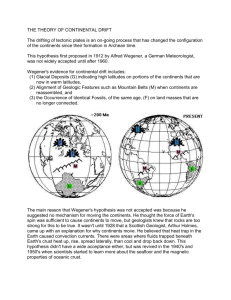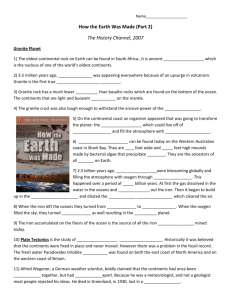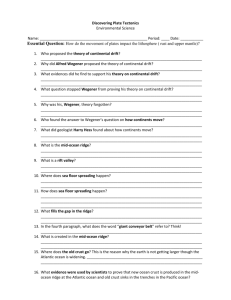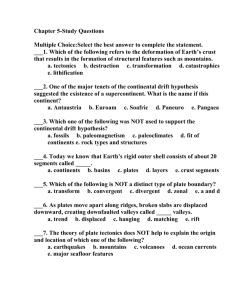Chapter 13
advertisement
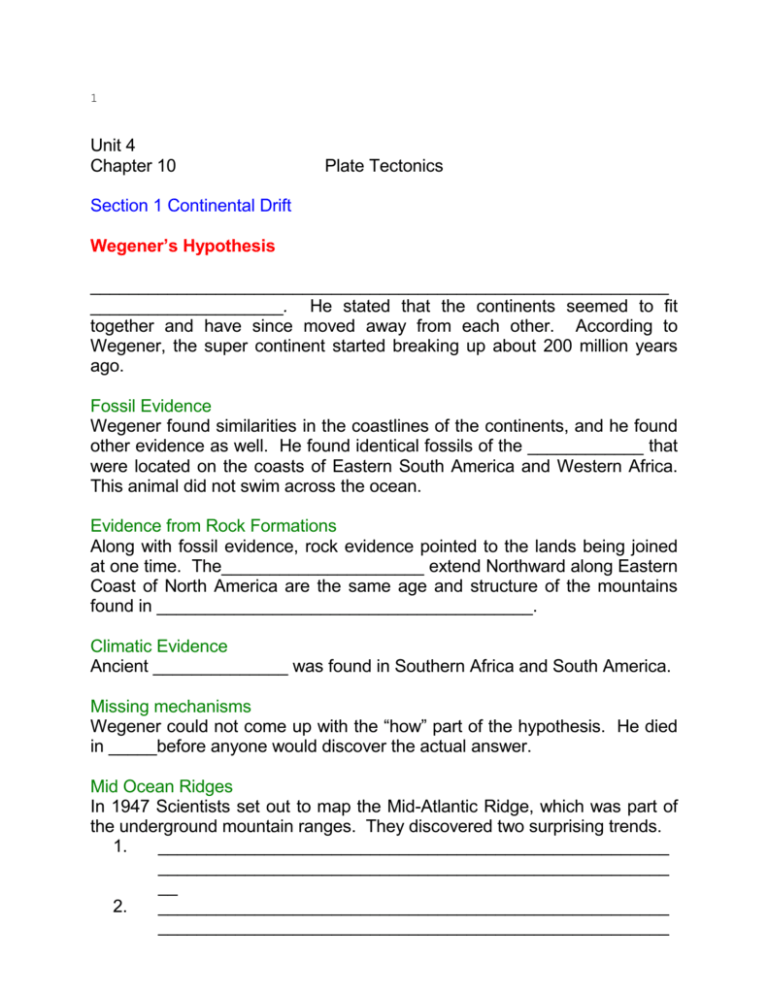
1 Unit 4 Chapter 10 Plate Tectonics Section 1 Continental Drift Wegener’s Hypothesis ____________________________________________________________ ____________________. He stated that the continents seemed to fit together and have since moved away from each other. According to Wegener, the super continent started breaking up about 200 million years ago. Fossil Evidence Wegener found similarities in the coastlines of the continents, and he found other evidence as well. He found identical fossils of the ____________ that were located on the coasts of Eastern South America and Western Africa. This animal did not swim across the ocean. Evidence from Rock Formations Along with fossil evidence, rock evidence pointed to the lands being joined at one time. The_____________________ extend Northward along Eastern Coast of North America are the same age and structure of the mountains found in _______________________________________. Climatic Evidence Ancient ______________ was found in Southern Africa and South America. Missing mechanisms Wegener could not come up with the “how” part of the hypothesis. He died in _____before anyone would discover the actual answer. Mid Ocean Ridges In 1947 Scientists set out to map the Mid-Atlantic Ridge, which was part of the underground mountain ranges. They discovered two surprising trends. 1. _____________________________________________________ _____________________________________________________ __ 2. _____________________________________________________ _____________________________________________________ 2 __ Sea-Floor Spreading In the late 1950’s geologist ___________came up with a new hypothesis. He proposed that the center valley was actually a ridge where molten rock would come to the surface and fill the cracks and push the land away. _____________renamed the process as “Sea Floor Spreading”. Hess’s hypothesizes were proven with more evidence discovered in the mid 1960’s. The evidence was discovered through paleomagnetism which is the study of the magnetic properties of rocks. Paleomagnetism Paleomagnetism_______________________________________________ ____________________________ _______________________ It has been discovered that Earth’s magnetic properties have changed orientation. Since the rocks magnetism goes along with the magnetic field, Scientists have discovered a pattern of normal (points north) and reversal (points south) magnetic orientations in rocks along the mid ocean ridge. The pattern it created is called the geomagnetic reversal time scale. ___________________________ Scientists discovered that our form the center of the mid ocean ridge to the edges of the continents a pattern of normal and reversed polarity formed. These patterns were mirror images on either side of the ridge. They also discovered the youngest rocks were on either side of the ridge with the oldest rocks by the continents. The symmetry of both the magnetic patterns and the rock ages supports Hess’s theory. 3 Wegener Redeemed Another group of scientists discovered the reversal pattern on land was similar to the one in the ocean. This added to the support of the continental drift theory. They also suggested that the mechanics involved was similar to a conveyor belt moving on both sides of the mid ocean ridge. Section 2 The Theory of Plate Tectonics ____________, the evidence supporting the continental drift theory and sea floor spreading lead to a new theory called Plate Tectonics. Plate Tectonics - _____________________________________________ __________________________________________________ How continents Move Lithosphere - solid layer of crust & uppermost part of the mantle -Similar composition (100 kms) Two types of crust Continental – ________________________________________________ Oceanic – ___________________________________________________ Asthenosphere - lower part of the lithosphere similar composition but much hotter almost melted - the rock flows in CONVECTION CURRENTS which allows the rigid upper crust to move. Tectonic Plates There are approximately 15 major plates that fit together on the earth’s surface like a jigsaw puzzle. http://www.p12.nysed.gov/osa/reftable/earthscience-rt/esrt2010-engw.pdf Earthquakes 4 _______________________________________________________ Volcanoes ____________________________________________________________ ____________________________________________________________ __ Types of Boundaries Boundaries are areas on Earth’s surface where volcanic and earthquake activity occurs. Diverging Boundaries Convergent Boundaries _________________________________________ - Subduction Boundary - __________________________________________ 5 Collision Boundary - _________________________________________ ____________________________________________________________ Transform Boundaries __________________________________________ ____________________________________________________________ _ Fault crack in the earth's crust where movement has occurred San Andrea's Fault moves 5cm/year Thin Skin Thrusting - pushing of thin rock layers at continental margins over long distance (Appalachian Mountains) Causes of Plate Motion Mantle convection is the driving force of the plates. movement of heated material. Convection is the 6 Mantle Convection This is the heat transfer through the mantle where less dense, heated material rises. The cooler denser material flows away from the hot material and sinks back into the mantle to replace the rising material. Moho – Real name Mohorovicic discontinuity It is the boundary between the crust and the mantle where dense rock of the mantle meets less dense rock of the crust. It is an average of 32 km under the continents, and 8 km under the sea. This is where most of the action occurs. __________________________ This happens when the cooling lithosphere slides down the slope formed by the elevation of the mid-ocean ridge. The force pushed the rest of the plate away. _______________________________ This happens when the leading edge of the subducting plate moves under the upper plate. It pulls the plate back into the asthenosphere. 7 Scientists believe that all three mechanisms together create the convecting system that makes the Earth’s tectonic plates move constantly. Section 3 The Changing Continents The continents did not always look they way they do now and through time, they will once again change shape and positions. Remember, we are Dynamic. Reshaping Earth’s Crust Craton – ___________________________________________________ Shields – ___________________________________________________ Rifting and Continental Breakup Rifting _______________________________________________________ ___________________________________________.It s the pressure build up that causes the crust to break and move. Terranes and Continental Growth Terrane It is a piece of lithosphere that has a unique geologic history 1. ________________________________________________ 2. ________________________________________________ 3. ________________________________________________ As oceanic crust subducts, a terrane is scraped off and becomes part of the continental crust (accretion). It can also be continental crusts colliding. The Himalaya Mountains formed this way 500 million years ago. 8 Effects of Continental Change When the continent moved, it changed the climate. The nearness of the continent to the equator or the poles brought about a different climate. The location by oceans and other continents plays an important role too. When continents move, they also change the flow of air round the globe. Change in Climate Geologic evidence shows ice once covered most of Earth’s surfaces. Even the Sahara had ice. This occurred about _____________________ when all the land was located near the South Pole. Change in Life The separating of the continents caused species to have to evolve into different ones. Isolation of species also caused life to adapt to its new environments. The Supercontinent Cycle When the continents are arranged as to create a large landmass called a ______________. These ________________break apart and can form new and different ones. This is called the Supercontinent cycle. Why Super Continents Form Supercontinents form when convergent boundaries between two continents collide, neither plate subducts, the boundaries become inactive and a new supercontinent is formed. When the pressure 9 builds up, the continent breaks apart. Formation of Pangaea Pangaea formed _____________________. It also formed the Appalachian Mountains and the Ural Mountains of Russia. The Tethys Sea cut into Pangaea and the ocean that surrounded it was later called Panthalassa. Break up of Pangaea _____________________during the Mesozoic Era, Pangaea broke up into 2 continents, Laurasia and Gondwanaland. Laurasia drifted northward and rotated and then split into North America and Eurasia with the North Atlantic Ocean between them. It also shrank the Tethys Sea to become the Mediterranean Ocean. Gondwanaland also changed, South America and Africa were formed. Then about ___________ years ago a split began to happen between South America and Africa opening up the South Atlantic Ocean. The other chunk of Gondwanaland broke to form India, Australia and the Antarctic. India started to move northward and at about 50 million years ago, it collided with Eurasia to form the Himalayan Mountains. The Modern Continents 10 As the continents continued to shift and collide, other features were formed. The __________________________________________________were all formed at this time. Geology of the Future Some Scientists believe in approximately 150 million years, Africa may collide with Eurasia and the Mediterranean will close. New subductive zones will form by the East Coast of North and South America and they will collide with Eurasia. The Atlantic Ocean will disappear. Mexico’s Baja Peninsula will become part of Alaska. In about 250 million years from now we will have another supercontinent.



